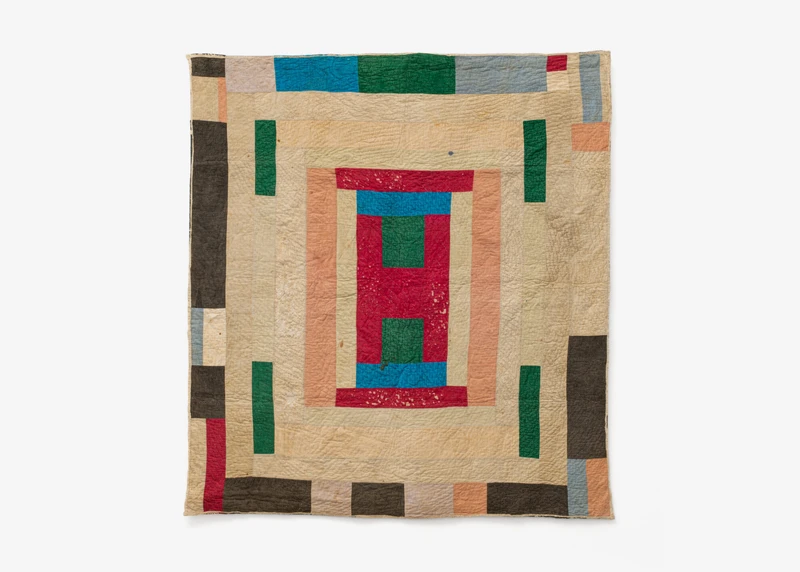Gee's Bend Quiltmakers


The Gee’s Bend Quiltmakers are an intergenerational community of women artists living in Gee’s Bend, officially known as Boykin, a remote hamlet situated on a U-turn in the Alabama River. The geographic isolation of Boykin has fostered a unique environment for both the women’s art and their chosen method of quilting, with their experimental processes and compositional language of the quilts have been passed down through generations of Gee’s Bend residents, from grandmothers to mothers to daughters. Indeed, family connections run through the quilting community like binding threads: Qunnie Pettway (b. 1943 – d. 2010), mother of Loretta Pettway Bennett (b. 1960) and auntie of Loretta Pettway (b. 1942). With their vernacular techniques preserved and uniquely interpreted by each generation, the quilts of the Gee’s Bend Quiltmakers signify both a collective past and a hope for the future.
Uninhibited by the conventions of fine or folk art, the Gee’s Bend quilts constitute a crucial chapter in the history of American art. The vivid and multi-layered textiles preserve numerous vocabularies and approaches to form; the interplay between symbols and asymmetry refers to histories of African textiles while also evoking the formal qualities of Modernist painting, something evidenced in the quilts of Sue Willie Seltzer (b. 1922 – d. 2010), Nancy Pettway (b. 1935) and Rebecca Myles Jones (b. 1896 – d. 1986). Forgoing more traditional art historical classifications, the quiltmakers organise their quilts into loose categories: ‘Abstraction & Improvisation’, ‘Pattern & Geometry’, ‘Housetop & Bricklayer’, ‘Lazy Gal’ and ‘Work Clothes’. These process-based taxonomies often lend the works their titles, as is demonstrated in Lucy Mingo’s (b.1931) ‘Housetop’ – ‘Log Cabin’ Variation (c. 1985) and Minder Coleman’s ‘Log Cabin’ – ‘Courthouse Steps’ Variation (Local Name: ‘Bricklayer’) (c. 1940). But the presence of such organisational parameters has never prevented formal experimentation: ‘Star’ – Ten-Block Variation (1937) by Nettie Young (b. 1916 – d. 2010) sees six and eight-point stars in gold, blue and red held within a patchwork lattice.
As Michael Kimmelman wrote in The New York Times in 2002, on the occasion of a major exhibition of 60 quilts at the Whitney Museum of American Art, first presented at the Museum of Fine Arts in Houston earlier that year: ‘the results, not incidentally, turn out to be some of the most miraculous works of modern art America has produced.’ Kimmelman continued: ‘These women, closely bound by family and custom […] spent their precious spare time – while not rearing children, chopping wood, hauling water and ploughing fields – splicing scraps of old cloth to make robust objects of amazingly refined, eccentric abstract designs.’ But the Gee’s Bend quilts were not sewn in the name of recreation alone – and neither were they originally conceived of as artworks. Instead, they were created out of necessity and a staunch belief that nothing should go to waste. When the nights grew cold, the women would stitch together scraps of fabric to insulate their children’s beds. Which is not to say that aesthetic consideration was not given. It was, and is, a common practice for the quiltmakers to publicly ‘air out’ their quilts every Spring, providing members of the local community with the opportunity to survey one another’s methods and take inspiration for their future designs.
The residents of Gee’s Bend are almost all descendants of slaves who worked on the original Pettway plantation – many bear the slaveowner’s name to this day. During the Civil Rights Movement, the community gained national recognition when they established the Freedom Quilting Bee, a co-operative that translated their centuries-old domestic craft into a viable economic enterprise and saw their quilts distributed across the country. In 1999, the Los Angeles Times featured Mary Lee Bendolph (b. 1935) in the Pulitzer Prize-winning article ‘Crossing Over’, an account of the community’s efforts to re-establish the Alabama River ferry service, which was suspended in 1967 by the white community who wanted to prevent the residents from registering to vote. In 2006, 39 years later, the ferry was reinstated. (Bendolph, daughter of Aolar Carson Mosely, b. 1912 – 1999, and mother of Essie Bendolph Pettway, b. 1956, is still quilting today.)
The first major museum exhibition dedicated to the Quilts of Gee’s Bend was presented in 2002 at the Museum of Fine Arts, Houston, and The Whitney Museum of American Art, New York, and featured such quiltmakers as Helen McCloud (b. 1938), Lutisha Pettway (b. 1925 – d. 2001); Polly Bennett (b. 1922 – d. 2003); and Rachel Carey George (b. 1908 – d. 2011), amongst others. In 2006, the book Gee’s Bend: The Architecture of the Quilt was launched at the Museum of Fine Arts, Houston; that same year, the U.S. Postal Service issued ten commemorative stamps featuring images of Gee’s Bend quilts. More recently, works were shown in ‘History Refused to Die: Highlights from the Souls Grown Deep Foundation’ at the Metropolitan Museum, New York (2018). The quilts of Gee’s Bend are now in many prominent museum collections including Philadelphia Museum of Art, Philadelphia; Fine Arts Museums of San Francisco; The Museum of Modern Art, New York; High Museum of Art, Atlanta; Museum of Fine Arts, Boston; and Tate, London.
Representation of the Gee’s Bend Quiltmakers involves working directly with the individual artists and in partnership with Souls Grown Deep, a non-profit organisation dedicated to the preservation and promotion of the contributions of African American artists from the Southern states. A percentage of the income generated with the Souls Grown Deep Foundation is reinvested into community projects in Boykin and the surrounding area, while a percentage of profits generated as a result of the gallery’s relationships with the artists will be reinvested in the community via future charitable enterprises.